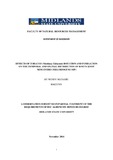Please use this identifier to cite or link to this item:
https://cris.library.msu.ac.zw//handle/11408/2532| Title: | Effects of tobacco (nicotiana tabacum) rotation and fumigation on the temporal and spatial distribution of roots-knot nematodes (meloidogyne ssp) | Authors: | Matashu, Wendy | Keywords: | Root-knot nematodes | Issue Date: | Nov-2014 | Publisher: | Midlands State University | Abstract: | Root-knot nematodes cause significant yield losses in tobacco (Nicotiana tabacum). Their management is essential for the grower to maximize production. Nematodes migrate up and down the soil profile in response to host availability. The objective of the study was to evaluate the effect of tobacco rotations on the spatial and temporal distribution of nematodes. Sampling was done every month from September 2010 to April 2011. The experimental design was a split-plot in a randomized complete block design. The main plot factor was fumigation and subplot factor was rotation. The rotations were sugar beans- tobacco, sunn hemp- tobacco, winter katambora - tobacco (all winter crops) and a fallow –tobacco. In each of the 8 treatments sampling was done at three different positions. At each sampling position sampling was done to a depth of 45cm at intervals of, (0-15 cm), (15-30 cm), (30-45 cm). Data was transformed and analysis of variance ANOVA was done using the statistical package Genstat (Version 7.22). No interactions were found between fumigation and rotations in all three depths (p>0.05). Significant differences (p<0.05) were recorded for the different rotations; In September 0-15cm the sugar beans rotation was significantly different. In March 15-30cm the winter katambora rotation was significantly different (p<0.05) and in January 30-45cm, the winter katambora rotation was significantly different (p<0.05). The spatial and temporal distribution of the nematodes in the three depths showed high nematode activity in the 0-15cm depth between March and April, while in the 15-30cm and 30-45cm depths, nematode populations were high between September and November. In conclusion sugar bean is not a suitable crop to include in tobacco rotations due to its susceptibility to nematodes. Winter katambora might not break the longevity of nematode eggs. In addition sampling should be done in April to obtain the correct nematode populations in the recommended sampling depth of 15cm-20cm. It is recommended that this experiment be repeated with a susceptible cultivar KM10 to obtain a good indication of the nematode distribution. It is also recommended that sunn hemp be used in tobacco rotations because it has the ability to suppress nematodes. | URI: | http://hdl.handle.net/11408/2532 |
| Appears in Collections: | Bsc Agronomy Honours Degree |
Files in This Item:
| File | Description | Size | Format | |
|---|---|---|---|---|
| FINAL WENDY DESERTATION FOR FINAL.pdf | Full Text | 1.14 MB | Adobe PDF |  View/Open |
Page view(s)
120
checked on Apr 4, 2025
Download(s)
94
checked on Apr 4, 2025
Google ScholarTM
Check
Items in MSUIR are protected by copyright, with all rights reserved, unless otherwise indicated.



